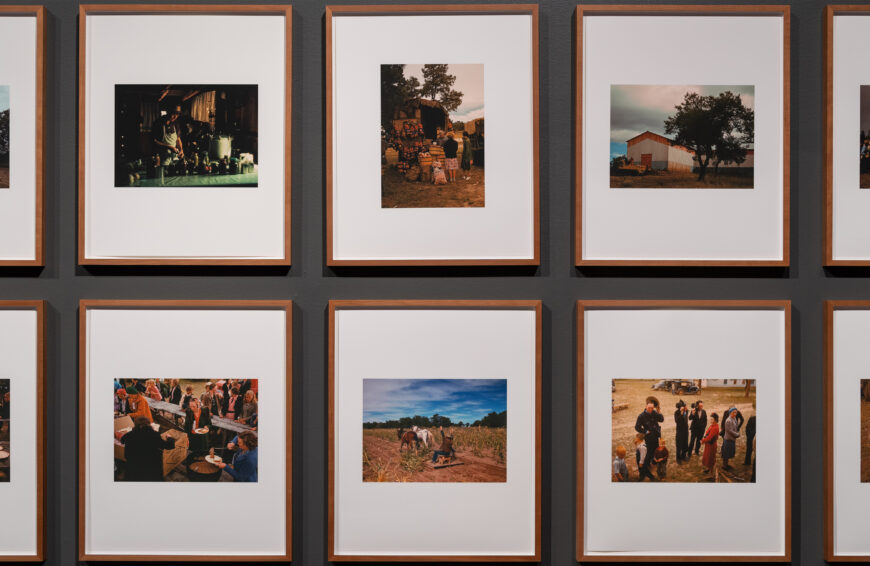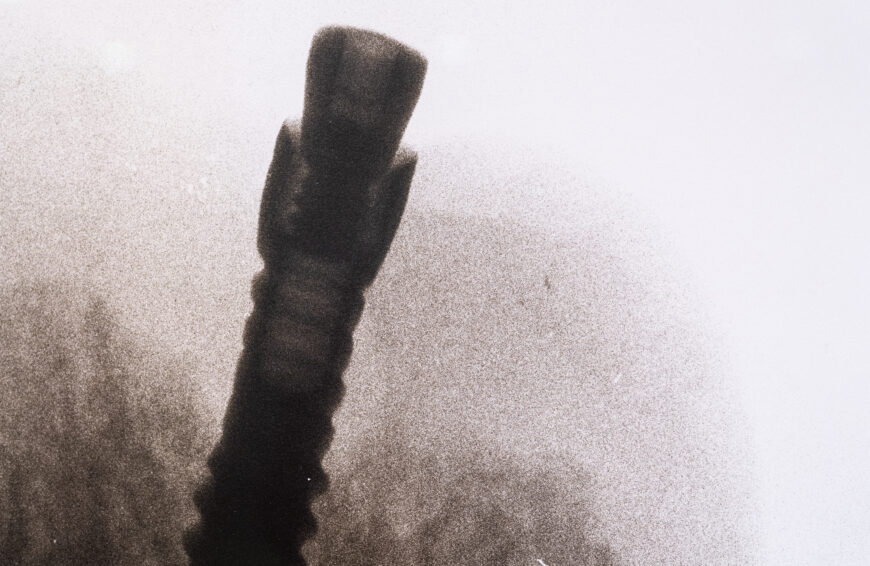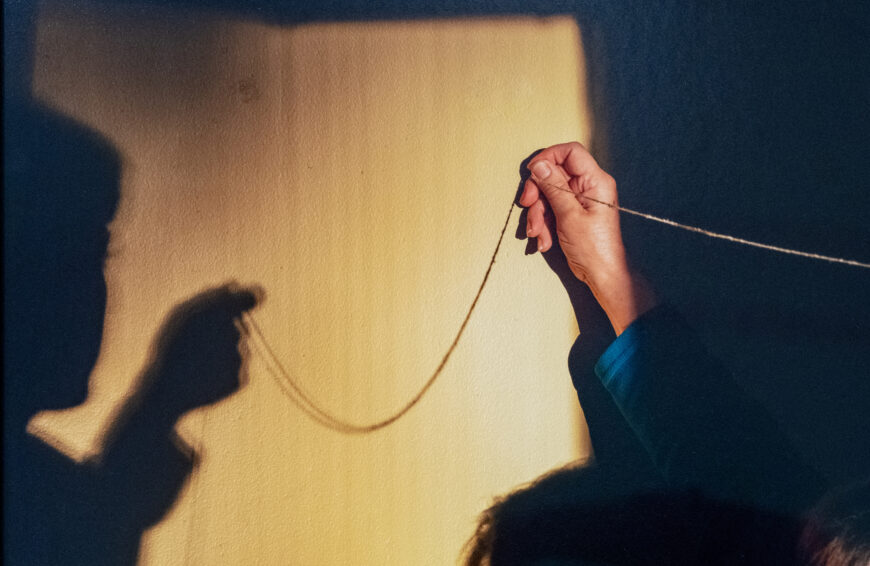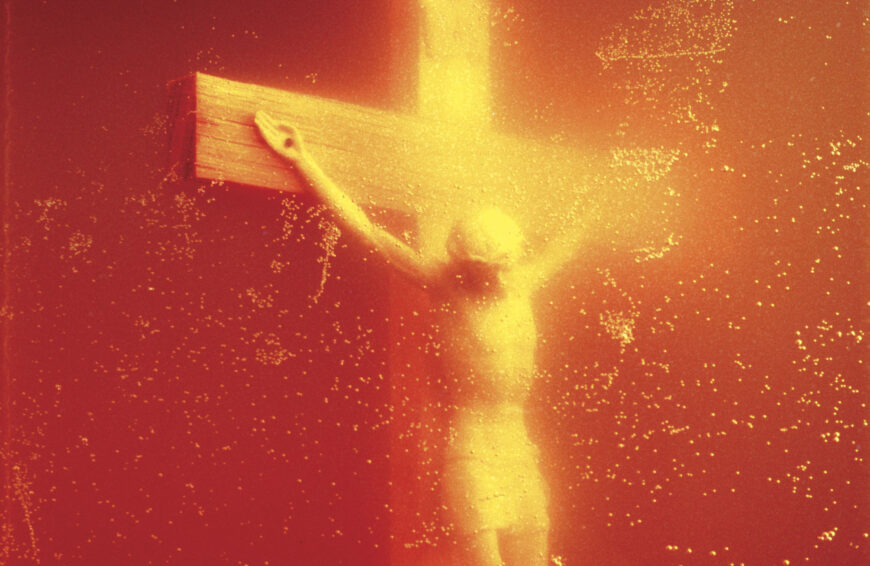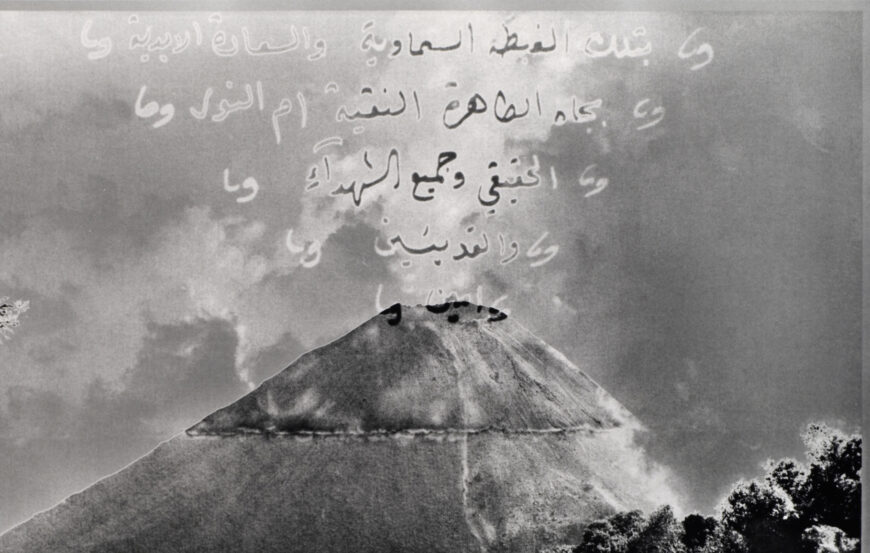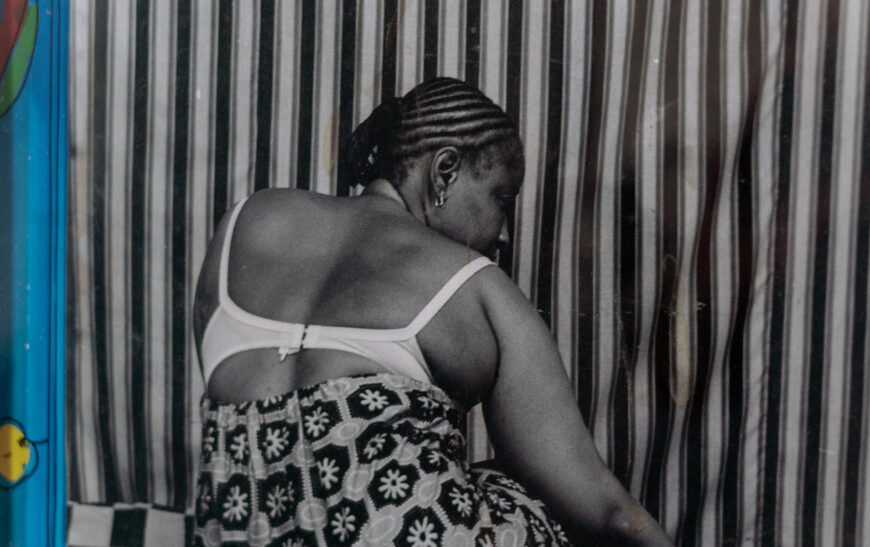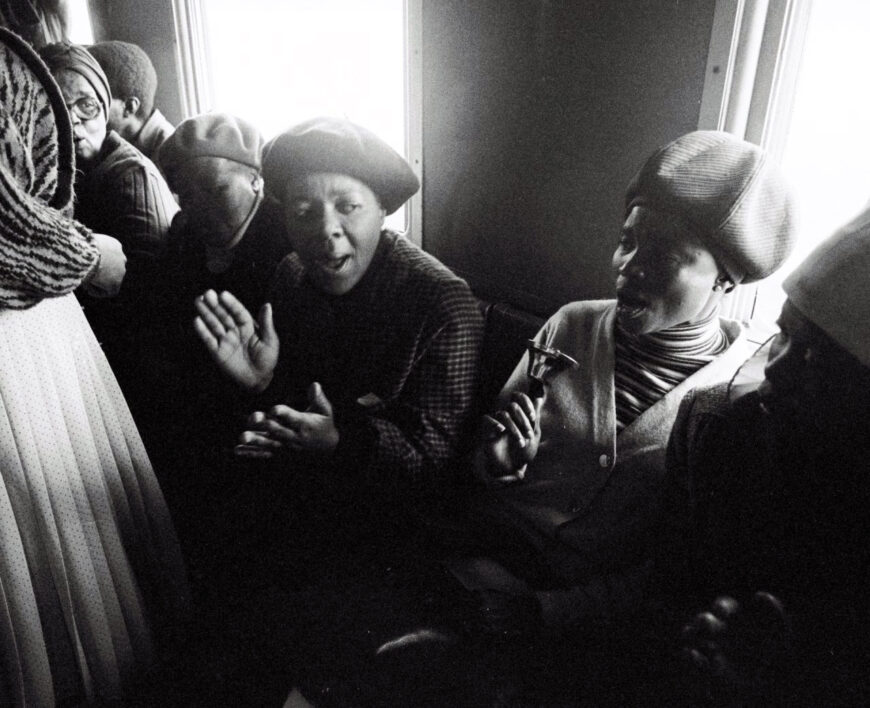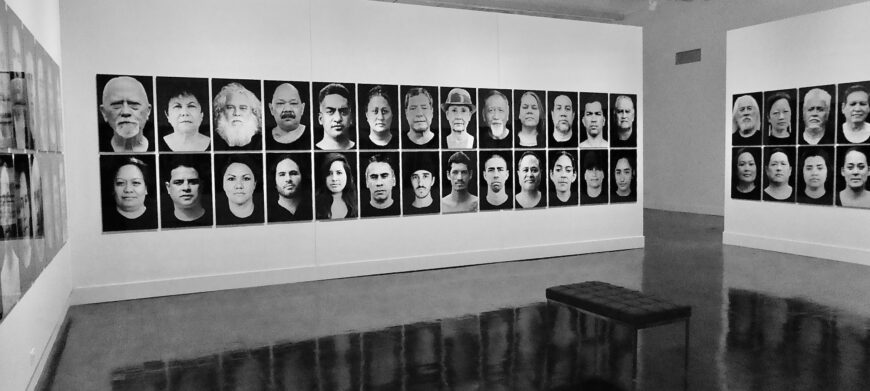
Kapulani Landgraf, ʻAuʻa, photograph installation, 2019, installed at the Honolulu Museum of Art, 2019 (Queensland Art Gallery and Gallery of Modern Art, Brisbane; photo: Stacy L. Kamehiro, CC BY-NC-SA 4.0) © Kapulani Landgraf, courtesy of the artist
Kanaka ʻŌʻiwi (Native Hawaiian) artist Kapulani Landgraf uses photography to document and communicate layered ideas related to Hawaiian history, culture, and political struggles. In 2019, she created a series of 108 black and white digital portrait photographs titled ʻAuʻa that was exhibited as a photographic installation at the Honolulu Museum of Art in 2019 and again in 2024. The portraits are of Native Hawaiian people who work in a variety of fields and represent multiple generations but are united in their commitment to Indigenous lifeways that have been long impacted by the U.S.-assisted overthrow of the Hawaiian Kingdom in 1893.
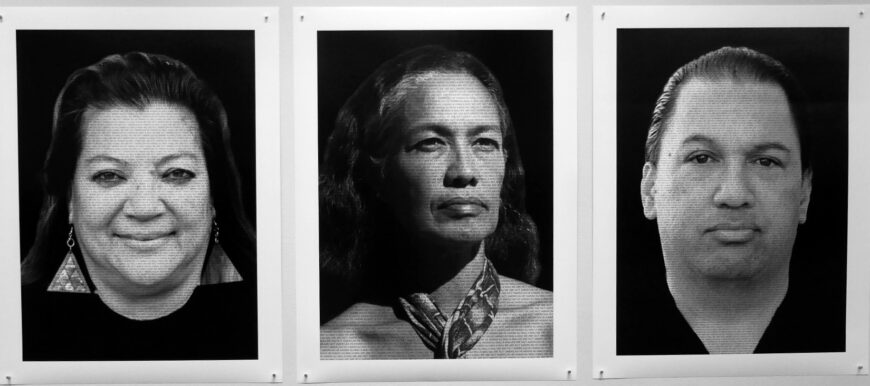
Three portraits with the center portrait depicting Haunani-Kay Trask (detail). Kapulani Landgraf, ʻAuʻa, photograph installation, 2019, installed at the Honolulu Museum of Art, 2024 (Honolulu Museum of Art; photo: Stacy L. Kamehiro, CC BY-NC-SA 4.0) © Kapulani Landgraf, courtesy of the artist
Facing Hawaiʻi’s colonial history
One of Landgraf’s portraits honors the influential Native Hawaiian scholar, activist, and poet Haunani-Kay Trask. Trask, through her academic and political activism, was a leader in the Hawaiian sovereignty movement. The movement focuses on self-determination and independence from the United States, which illegally annexed the Hawaiian Islands as a territory in 1898. Her writings, speeches, and advocacy are revolutionary critiques of U.S. imperialism and colonialism in Hawaiʻi. In the photograph, Trask defiantly looks out past the viewer in a pāʻū (a wraparound garment or sarong)—she does not wear any Euro-American clothing that might indicate an allegiance to the U.S. By featuring Trask, Landgraf evokes the Hawaiian sovereignty movement and its fight for Native Hawaiian rights and culture in response to the effects of colonialism, tourism, overdevelopment, and militarization of Hawaiian lands.
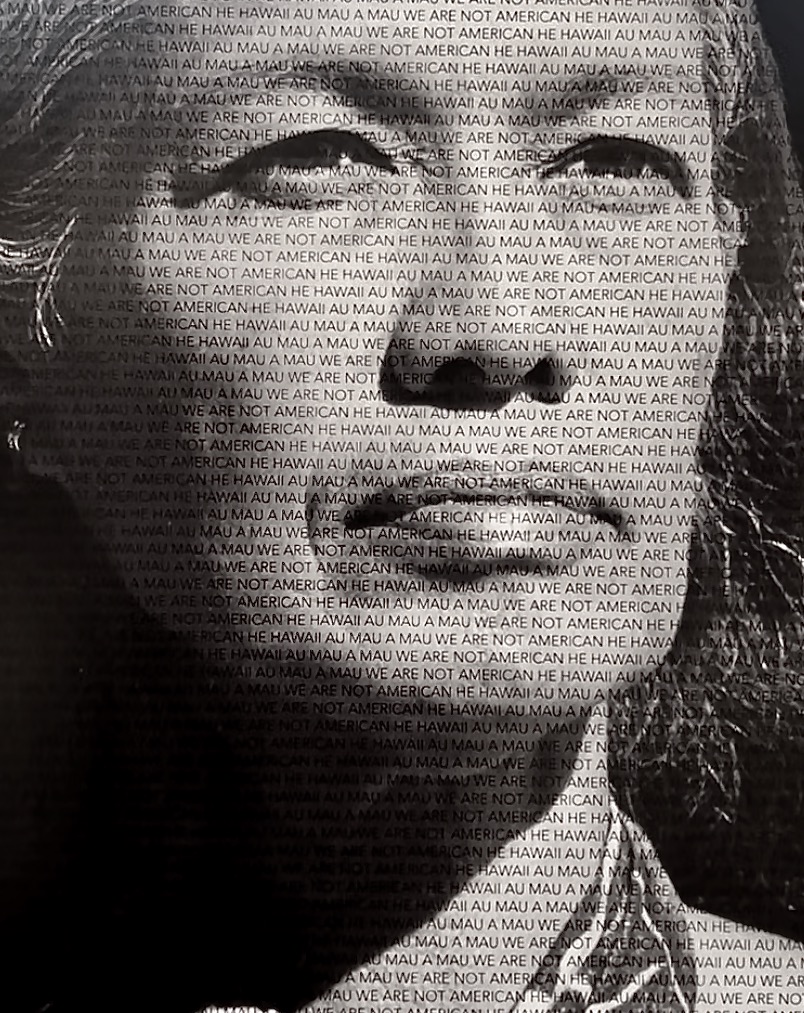
Haunani-Kay Trask (detail). Kapulani Landgraf, ʻAuʻa, photograph installation, 2019, installed at the Honolulu Museum of Art, 2024 (Honolulu Museum of Art; photo: Nicole K. Furtado) © Kapulani Landgraf, courtesy of the artist
The repeated phrase, “WE ARE NOT AMERICAN HE HAWAII AU MAU A MAU,” printed in capital letters, appears in small print across her entire image. “He Hawaii Au Mau A Mau” translates as “I am Hawaiian, forever and ever.” Continuously repeating the combined phrases throughout her image, as well as in all the other portraits in ʻAuʻa, communicates persistence and unrelenting dedication to restoring Native Hawaiian self-determination. The text envelops Trask, as if to indicate that she and the movement are one and the same. The words are derived from one of Trask’s most famous speeches delivered at a protest march on January 17, 1993—the 100-year anniversary of the illegal overthrow of Queen Liliʻuokalani and the Hawaiian monarchy. In front of ʻIolani Palace—once Liliʻuokalani’s seat of rulership and later the site of her imprisonment—in Honolulu, Trask famously declared, “We are not American. We will die as Hawaiians. We will never be Americans.” Her words are a call to revitalize Hawaiian identity and reckon with the struggles caused by U.S. settler colonialism.
The same textual provocation appears across the 108 portraits, joining all the individuals who agreed to participate (and who are diverse in age and vocation) in challenging ongoing colonization, asserting Hawaiian national identity, and collectively committing to effect lasting change. Image and text are layered together as though to emphasize the human, personal embodiment of the words. The repeated phrase urges the viewer to recognize Hawaiʻi’s colonial history and truly “face” it—emphasized by the larger than life-size-scale format of the prints and the direct gaze of the sitters—and contend with it in our present moment. The title of the installation, ʻAuʻa, adds depth to the declaration because it can mean to withhold or deny something, or to refuse to part with something. The participants in Landgraf’s work can be understood as united in withholding their citizenship from the United States and refusing to part with their Hawaiian national identity.
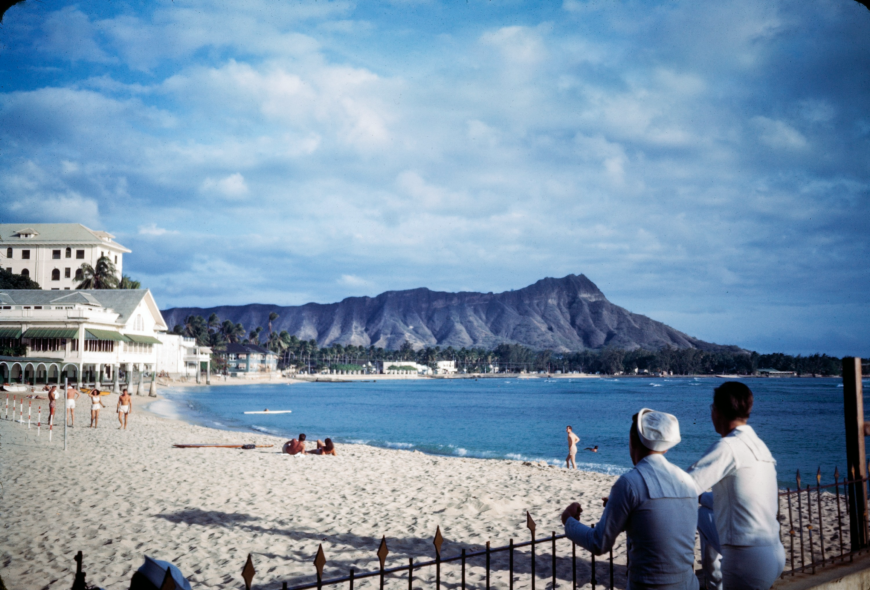
James Kirkpatrick, Waikiki Beach, Honolulu, Hawaii, 1945 (National Air and Space Museum Archives, Chantilly)
Multiple layers of meaning
Presenting the portraits in black and white also has layered significance. It recalls an era predating the invention of color photography—the time of the 1893 overthrow of the Hawaiian monarchy and the 19th century more generally, when the foundation for settler colonialism in Hawaiʻi was established and quickly advanced. The black and white format reminds viewers that Kānaka ʻŌʻiwi have endured cultural trauma and pain and have also fought to defend their sovereignty for nearly two centuries. Landgraf’s stylistic choice also offers a stark contrast to the omnipresent color-saturated photography deployed to draw tourism, especially since the post-World War II advances in transportation and explosion of visitor accommodations and services in Hawaiʻi. Vibrant, multi-hued photographs advertising a fantasy of Hawaiʻi’s pristine, untouched beaches, without a trace of Indigenous inhabitants, or smiling and welcoming “hula girls” entice tourists (many of whom settle in Hawaiʻi). These types of images mask the violence of colonial displacement, efforts to eliminate Hawaiian language and culture, and the exploitation of land and labor. Landgraf’s photographic collectivity of community leaders forcefully counter these seductive representations. The majority of the people featured in the portraits confront viewers directly and solemnly, except for the notable exception of Trask who gazes into the distance—into the future perhaps. The size of the portraits signals their presence, the textual declaration unifies them, and the black and white format evokes the long history of the struggle and their enduring dedication to correct historical and present-day wrongs enacted on the land and people of Hawaiʻi.
The aesthetic device of skillfully layering meanings in Hawaiian visual and material culture, poetry, literature, and performance is called kaona and elicits multiple, simultaneous, and interrelated stories and ideas. As with her other major artworks, Landgraf’s ‘Auʻa invites viewers to engage multiple layers of meaning. She accomplishes this through the formal and conceptual elements described above, and also through other aspects of the installation. For both the 2019 and 2024 exhibitions of ‘Auʻa, she presented all of the wall labels in both ‘Ōlelo Hawaiʻi (the Hawaiian language) and English and played looped audio recordings of Trask’s speech and a song (mele) related to the theme of the installation, ‘Auʻa ‘ia, performed by Kaleo Trinidad and Aaron J. Salā. For the 2024 installation, Landgraf added a large bilingual wall text reproducing a name song (mele inoa) honoring Kama, a famous Maui chief, who refused to surrender his land.
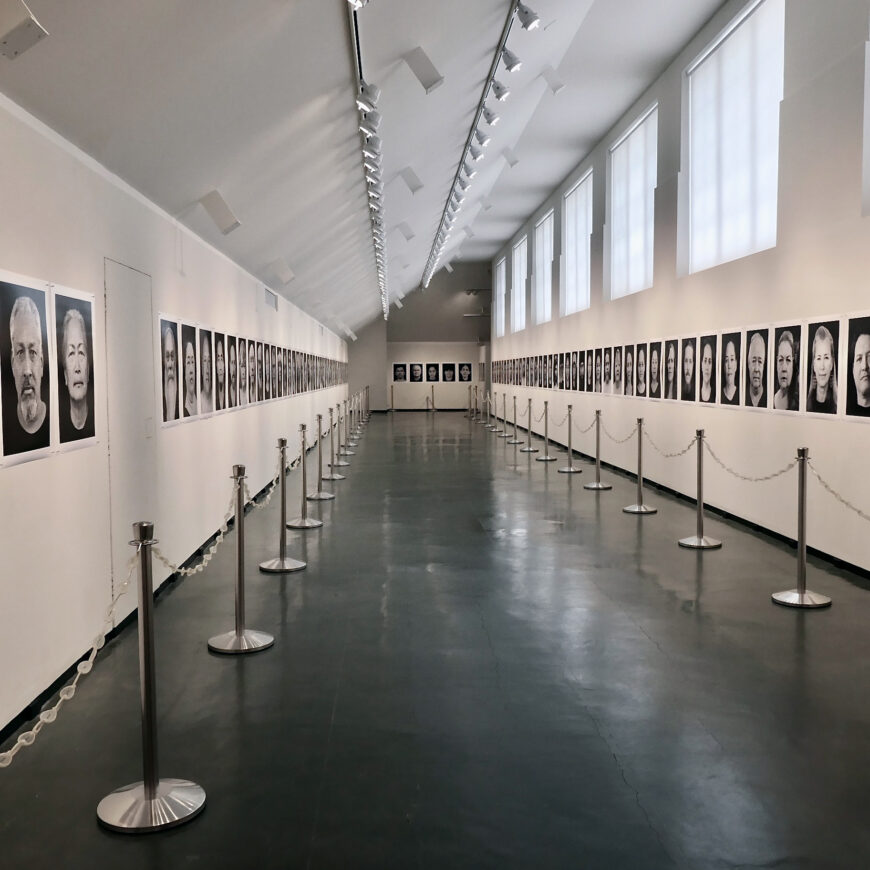
Installation with Pili Ma Nā Kūpuna (detail), Kapulani Landgraf, ʻAuʻa, photograph installation, 2019, installed at the Honolulu Museum of Art, 2024 (Honolulu Museum of Art; photo: Stacy L. Kamehiro, CC BY-NC-SA 4.0) © Kapulani Landgraf, courtesy of the artist
Pili Ma Nā Kūpuna
For this later installation, Landgraf also created a new work in 2023, Pili Ma Nā Kūpuna, that took the form of a chain barrier supported by metal stanchions that serve to physically protect the portraits by keeping viewers at a distance. This had the additional benefit of not having to mount the photographs with plexiglass that could reflect the exhibition lighting and impede clear viewing. Landgraf constructed the chain of zip ties, which are often used by police forces to restrain protestors and, in the context of the installation, can be seen as suppressing Hawaiian sovereignty. At the same time, the barrier can be understood as safeguarding the community as they stand their ground, which is visually and spatially emphasized by the installation design that presents the photographs in a long single row on each of the gallery walls.

Chain inscribed with the names of participants’ ancestors (detail), Kapulani Landgraf, Pili Ma Nā Kūpuna, 2023, nylon zip ties, pig naʻau, ink, exhibited as part of ʻAuʻa, installed at the Honolulu Museum of Art, 2024 (photo: Stacy L. Kamehiro, CC BY-NC-SA 4.0) © Kapulani Landgraf, courtesy of the artist
The zip ties are covered in a membrane of pig naʻau (intestines) that harden when dried. Landgraf inscribed the surface of the naʻau stretched over the loops of the zip ties with the names of kūpuna (ancestors) offered by the project participants. Placed on the links of the chain, the names form an unbroken historical and genealogical connection between Kānaka ‘Ōʻiwi, past and present, and suggest their unyielding solidarity. Drawing on the function of the barrier to protect and keep away those who might cause harm (to the artwork, and more broadly to Kānaka ‘Ōʻiwi and their cause), the community leaders’ ancestors guard them and their work as they shape the future. Like the black and white format of the photographs, the chain barrier provides an historical reference and signals the persistent struggle of the sovereignty movement. As Landgraf states, “even though there are just 108 people represented, there are thousands there, representing generations upon generations of our ancestors and future descendants.” [1] Naʻau is also an important Hawaiian concept that not only means “gut” or “intestines,” but also refers to “intellect, feeling, and moral sense” and “of the heart or mind” (somewhat akin to the phrase “gut feeling” or “trusting your gut”), and adds another layer of meaning to the piece. [2] Together, ʻAuʻa and Pili Ma Nā Kūpuna encourage viewers—whether they be Native Hawaiians, settlers, tourists, or others—to open their hearts and minds to learn about Kanaka ʻŌʻiwi relationships to their lands and the histories of Hawaiian struggles while acknowledging multi-layered and meaningful connections to place.


